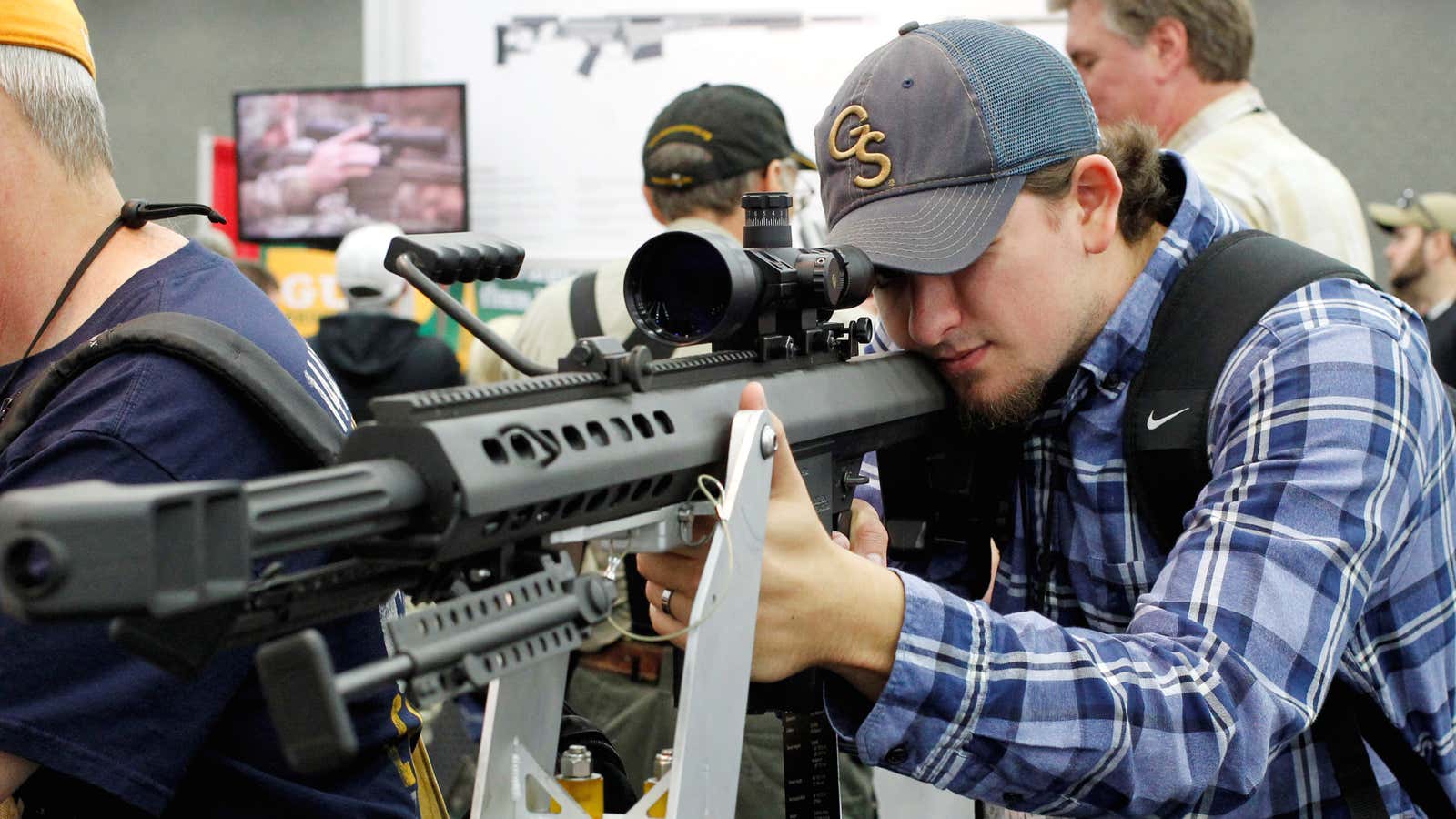Men kill. They kill in Hollywood films, where men like James Bond to Rambo unleash satisfying uberviolence. And they kill, too often, in real life. In mass shootings, as Damon Linker points out, the perpetrators are men 98% of the time.
Many writers have noted that mass shooters often have a history of domestic violence and spousal abuse. Toxic masculinity—the belief that men can prove their masculinity through violence—inspires violence. Men are a threat to everyone who isn’t a man, from the children of Sandy Hook elementary to the sorority sisters murdered by Elliot Rodger.
But while men with guns are certainly a threat to women and children, men are not just perpetrators of violence. They are also victims. In fact, men are much, much more likely to be killed by gun violence than anyone else in the US.
A shocking study of gun violence conducted by the Kaiser Family Foundation in 2014 found that in that year, 18 males died of gun violence per 100,000 Americans, as compared to only 3 females. In other words, men accounted for more than 85% of gun deaths in the United States. If toxic masculinity is responsible for gun deaths, then, overwhelmingly, the victims of toxic masculinity are men themselves.
The disproportionate victimization of men by gun violence is hidden in part by the influence mass shootings hold in the popular imagination. It’s true that in some of the most high profile shootings, many victims are women and children. But mass shootings account for only a tiny fraction of gun deaths in the United States..
In fact, the biggest share of gun deaths are suicides. Around 21200 people killed themselves with guns in 2013 according to the Centers for Disease Control (CDC)—and the majority of those were men. Men account for close to 80 percent of suicides in the United States; most of those deaths are gun related.
But men are also much more likely to be the victims of homicides than women. Between 1980 and 2008, men were 77% of all homicide victims, with 11.6 men per 100,000 suffering homicide in comparison with only 3.4 women. Again, gun violence accounts for a disproportionate rate of homicide deaths. The figures are even more shocking when you look at firearm homicide rates for black men between 20-29 specifically. Death rates for this group are 89 per 100,000 people. According to the Brookings Institute, that’s similar to the death rate in Honduras, which has the highest homicide rate in the world.
Men, then, are far more likely to be the victims of suicides and of homicides. The reason, according to Liza Gold, professor of psychiatry at Georgetown, is surprisingly sinple. Men are more likely to be killed by guns, through suicide, homicide, or accident, because men are more likely to have guns. “Overwhelmingly the people who own guns are going to be the people who are endangered by the guns,” Gold says. “Guns are historically, stereotypically a masculine sort of thing.” And that puts men at risk.
The idea that guns protect people from gun violence is a myth. Where there is more gun ownership, there are more gun deaths, and people with guns in the home are more at risk of gun homicide and gun suicide.
Men are three times more likely to own guns than women. The proliferation of guns in the United States, then, results in the death—overwhelmingly, disproportionately—of men. More importantly, this drip-drip, day-by-day carnage has become something akin to tolerable in large part because gender stereotypes make it more difficult to portray men as victims of violence. (For other examples of this phenomenon, just look at how difficult it is to tackle problems like male rape, or domestic abuse against male partners.)
“Across a very broad spectrum of ideologies and cultures, we tend to understand males as natural, inevitable, and inconsequential victims of violence,” Adam Jones, a professor of political science at the University of British Columbia, Okanagan, told Quartz. ” For the most part, male victims and survivors are written off and written out. They’re expendable.” When men die, in other words, it’s not tragic, in other words, it’s natural.
This is also why the gun control debate seems to only heat up when women or children are killed in mass shootings. Traditional conservative gender roles place men as violent aggressors or as protectors, shielding women and children from other men. Some feminist accounts of violence also have trouble seeing or thinking about men as victims. Unfortunately, both depictions of men play into the same toxic masculinity that feminists, rightly, critique. As long as men are seen only as perpetrators of gun violence, then guns, for many men, are going to symbolize power, excitement, and strength.
But the truth is that guns, mostly, don’t make men strong. They make them dead. Gun control, by the numbers, is a campaign to keep men from dying. If we don’t see, or don’t care about, male victims, it’s hard to see how we’ll ever be able to stop the violence directed against them, and against those around them.
